Tow truck
A tow truck (also called a wrecker, a breakdown truck, recovery vehicle or a breakdown lorry) is a truck used to move disabled, improperly parked, impounded, or otherwise indisposed motor vehicles. This may involve recovering a vehicle damaged in an accident, returning one to a drivable surface in a mishap or inclement weather, or towing or transporting one via flatbed to a repair shop or other location.
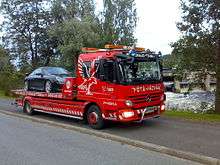
A tow truck is distinct from a car carrier trailer, which is used to move multiple new or used vehicles simultaneously in routine transport operations.
History
.jpg)
Ferdinand Porsche of Austro-Daimler developed an artillery tractor for the Austro-Hungarian army in 1908, the M 08. One of the batch was constructed as a recovery vehicle for the others, with a large winch on the rear platform.[1]
The wrecker (with lifting jib) was invented in 1916 by Ernest Holmes Sr. of Chattanooga, Tennessee, a garage worker who was inspired after he needed blocks, ropes, and six men to pull a car out of a creek. After improving his design he began manufacturing them commercially.[2] The International Towing and Recovery Hall of Fame and Museum in his home town displays restored antique wreckers, tools, equipment, and pictorial histories of the industry Holmes created.
Types of towing equipment
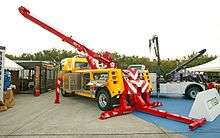
Five general types of tow truck are in common usage, usually based on the type or size of vehicle to be towed:
- Boom: use an adjustable boom with a winch to recover vehicles from a ditch, over an embankment, or any place the vehicle cannot be safely reach backing-up. Some booms are fixed, some heavy pivoting A-frames, others hydraulic-powered telescoping tubes. The heaviest types of boom can rotate, effectively turning the tow truck into a sort of mobile crane, called a "rotator", and are usually reserved for heavy vehicle accidents.[3] In the past boom trucks used a "hook and chain" system where chains are looped around the vehicle frame or axle, then lifted by a boom winch. A towbar with heavy rubberized mats connects the truck and vehicle, so it can be towed on its other axle. "Slings" and "belt lifts" are an evolution, with rubber straps replacing part of the chains.[4][5][6] Slings are not used much today because they can scratch the bumpers of cars. But they are sometimes used for towing vehicles that have been in an accident or have one or two of the front or rear wheels missing or for pickup trucks and other vehicles that have steel bumpers. Cars equipped with all-wheel drive cannot be towed with a sling, since it can cause problems with the car's drivetrain.[7]
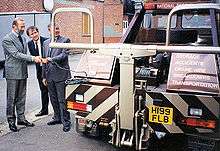
- Wheel-lift (also called a "spectacle lift" or "underlift"): evolved from the hook and chain technology to produce a large metal yoke that can be fitted under the front or rear wheels to cradle them, drawing the front or rear end of the vehicle clear of the ground by a pneumatic or hydraulic hoist so it can be towed. This apparatus generally picks up the drive wheels of the vehicle (i.e. the front wheels if it is front wheel drive, the rear wheels if it is rear wheel drive) touching only the tires.[5] The wheel lift was designed by Arthur W. Nelson of Weld Built Body Co. in 1967.[8] The name spectacle lift is common in Europe; the cradle resembles a pair of squared spectacles (eyeglasses). Medium and heavy trucks use a variation, the "underlift" or "chassis lift", which lifts the axle or frame instead of the wheels. Wheel-lift trucks can have adapters which can also lift the chassis.[4]
- Integrated (also called a "Self Loader", "Snatcher", "Quick Pick" or "Repo Truck"): boom and wheel-lift integrated into one unit. Used in light duty trucks to repossess vehicles or move illegally parked vehicles. Most have controls for the apparatus inside the cab of the tow truck to make quick pickup possible without the inconvenience of exiting the truck to hook up the vehicle.[9][10] Heavy duty trucks are also manufactured with integrated lift.
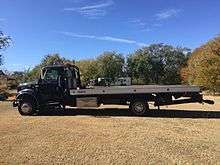
- Flatbed (also called a "rollback", "slide" or "tilt tray"): the entire back of the truck is fitted with a bed that can be hydraulically inclined and slid back to ground level, allowing the vehicle to be placed on it under its own power or pulled on by a winch.[11] Because they carry, rather than tow the vehicle, it can be completely immobilized; in the US they are used to carry badly damaged cars from crashes.

- Lift flatbed: a boom uses a wheel-lift frame to lift the vehicle vertically and load it on the bed. Used in Europe, this truck can remove vehicles that are parallel-parked.
These are the most common arrangements, but are by no means exclusive, as there are flatbed units that offer a wheel-lift, boom trucks that can recover but not tow, and wheel-lift units that offer a combination boom with sling.
There are also several sizes and weight categories of tow truck. The lightest models are usually based on light truck and van chassis offering boom and tow weights of around 5-to-10 tons, making them ideal for car towing. Most flatbed-type vehicles are based on medium duty and heavy duty trucks to provide the chassis strength necessary to carry entire vehicles. A step up from that are medium-duty tow trucks offering boom capacity of 15–20 tons. Heavier still are the heavy duty tow trucks based on chassis used by semi trucks, with multiple axles and the ability to tow fully loaded semi truck and trailer combinations, with boom capacity from 25 to 50 tons. At the top are the rotators, which can range from 40 tons to 75 tons (though lighter models do exist as seen at the right) and often come with a wealth of other features per customer specification.[12]
Operations
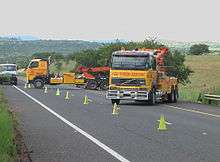

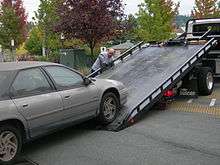
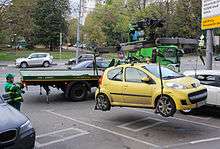

Tow trucks are usually operated by private businesses, except for major highways and toll roads, where the road authority may operate the tow trucks for that stretch of road. Some police departments own tow trucks, but in the US it is common to contract police tows to private companies. Businesses who operate a large fleet of vehicles, such as school bus companies or package delivery services, often own one or several tow trucks for the purposes of towing their own vehicles. Government departments with large fleets (such as the police departments, fire departments, transportation authorities and departments of public works of major cities) may similarly own tow truck(s). Police department tow trucks may also be used to impound other vehicles. Heavy tow trucks are often called to clear semi truck accidents and straighten out jackknifed trucks. In rural or unorganized areas, companies which operate tow trucks can sometimes also offer additional services appropriate to highway clearance where government-provided ones are unavailable, such as fire suppression.
The military also deploys tow trucks for recovery of stranded vehicles. In the US Army, a variant of the HEMTT truck is used for this purpose, the M984 wrecker.[13] For recovery in combat situations while under fire, many armies with large vehicle fleets also deploy armoured recovery vehicles. These vehicles fulfill a similar role, but are resistant to heavy fire and capable of traversing rough terrain with their tracks, as well as towing vehicles beyond the weight limits of wheeled wreckers, such as tanks (many are based on tank designs for this very reason).[14]
Each state and territory of Australia has its own regulations and acts for the operation of tow trucks. Tow trucks are generally divided into two categories, either by standard, trade and private towing or Accident Towing. Accident Towing tow trucks are clearly identifiable by number plates ending in either "ATT" or "TT". Tow trucks which are not endorsed for "accident towing may use general number plates of any combination pursuant to each states own registering system. An example of a statute regulating the operation of tow trucks and the towing industry in Victoria is the Victorian Accident Towing Services Act.[15]
See also
| Wikimedia Commons has media related to Tow trucks. |
- Armored recovery vehicle
- Impounded vehicle auction
- Mater, a character in the animated Disney production Cars
- Motor carrier
- Roadside assistance
- Tow hitch
- Vehicle recovery
References
- Ludvigsen, Karl (2014). "Chapter 2: Power to the Dual Monarchy". Professor Porsche's Wars. Pen & Sword Military. pp. 16, 18–19, 21. ISBN 978-1-52672-679-7.
- "Entrepreneurial Hall of fame inducts three". University of Tennessee at Chattanooga. May 17, 2007. Archived from the original on June 23, 2010. Retrieved August 29, 2009.
- "Challenger Rotator 9909 | Feature | Features". Car and Driver. Retrieved January 24, 2018.
- "HDR 70/85 Wrecker Operations and Maintenance Manual" (PDF). Jerr-Dan. 2010. pp. 33–68. Retrieved 13 September 2016.
- "Owner's Manual 820 Wrecker/FIIIT" (PDF). Miller Industries. 1997. pp. III 1–5, IIIA 1–4, IV 1–8, IVA 1–20. Retrieved 13 September 2016.
- "MPL Tow Sling Operation Supplement Manual" (PDF). Jerr-Dan. 2007. Retrieved 13 September 2016.
- "How to tow a four-wheel-drive vehicle". HowStuffWorks. Retrieved 9 April 2014.
- A US patent 3434607 A, "Automobile Towing device". Retrieved 12 September 2016.
- "SL3 Highspeed and volume (sales site)". Metro tow Trucks. 2006. Retrieved 22 September 2016.
- "US patent 20050111948 A1 Integrated boom, tow bar, and wheel lift tow truck assembly". Google.com. 20 November 2003. Retrieved 22 September 2016.
- "Standard Duty Carrier Medium Duty Carrier Heavy Duty Carrier Operations and Maintenance Manual" (PDF). Jerr-Dan. 2014. Retrieved 13 Sep 2016.
- "12.14.080 Tow truck classifications". qcode.us. Retrieved January 24, 2018.
- "Heavy Expanded Mobility Tactical Truck". Military.com. Retrieved January 24, 2018.
- "M88A2 HERCULES Armoured Recovery Vehicle - Army Technology". Army Technology. Retrieved January 24, 2018.
- "Information for the towing industry". VicRoads. February 13, 2017. Retrieved January 26, 2018.